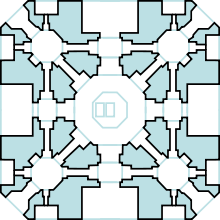Hasht-Bihisht (Architecture)

In architecture Hasht-Bihisht (lit. Persian - Eight Paradises) refers to a specific type of floorplan common in Persian architecture and Mughal architecture whereby the plan is divided into 8 chambers surrounding a central room.
The eight divisions and frequent octagonal forms of such structures represent the eight levels of paradise for Muslims. The paradigm however was not confined solely to Islamic antecedents. The Chinese magic square was employed for numerous purposes including crop rotation and also finds a Muslim expression in the wafq of their mathematicians. Ninefold schemes find particular resonance in the Indian mandalas, the cosmic maps of Hinduism and Buddhism.[1]
Persia
The Hasht-Bihisht plan was used at the Tarabkhana pavilion in Timurid Herat, Afghanistan, a two-storied structure that seems to have adopted the octagonal hasht bihisht form, in nine units (the eight surrounding bays and a ninth central bay. No longer extant, this form is repeated at the seventeenth-century Hasht Behesht Pavilion of the Safavid Empire imperial palace at Isfahan.[2]
Mughal India
The Hasht-Bihisht was the favourite form for both Mughal garden pavilions and mausolea (seen as a funerary form of pavilion). These were square or rectangular planned buildings divided into nine sections such that a central domed chamber is surrounded by eight elements.
Later developments of the hasht bihisht divided the square at 45 degree angles to create a more radial plan which often also includes chamfered corners; examples of which can be found in Todar Mal's Baradari at Fatehpur Sikri and Humayun's Tomb. Each element of the plan is reflected in the elevations with iwans and the corner rooms expressed through smaller arched niches. Often such structures are topped with chattris, small pillared pavilions at each corner.
See also
- Hasht Behesht - Safavid Isfahan palace
- Islamic architectural elements - index
Citations
References
- Koch, Ebba. The Complete Taj Mahal: And the Riverfront Gardens of Agra (Hardback) (First ed.). Thames & Hudson Ltd. 288 pages. ISBN 0-500-34209-1.
- Ruggles, D. Fairchild. “Humayun’s Tomb and Garden: Typology and Visual Order.” In Attilio Petruccioli, ed. Gardens in the Time of the Great Muslim Empires: Theory and Design. Studies in Islamic Art and Architecture: Supplements to Muqarnas, Volume VII. Leiden: Brill, 1997, 173-186.